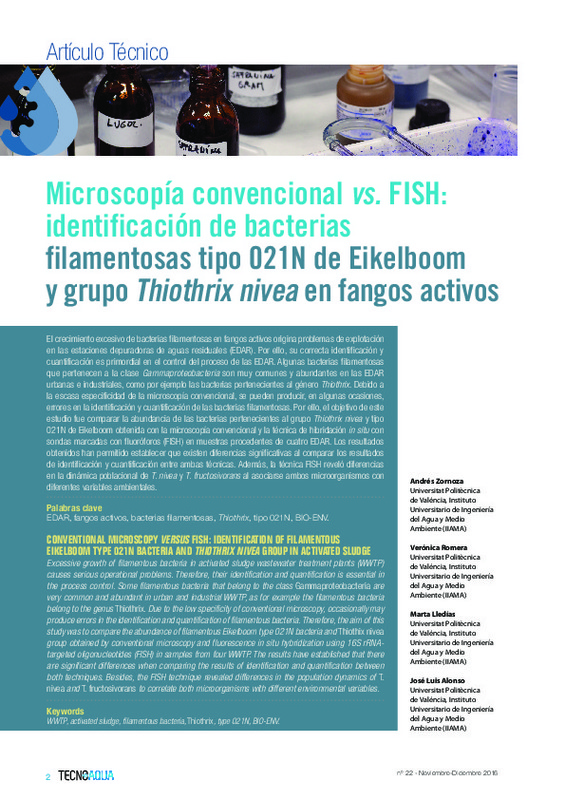JavaScript is disabled for your browser. Some features of this site may not work without it.
Buscar en RiuNet
Listar
Mi cuenta
Estadísticas
Ayuda RiuNet
Admin. UPV
Microscopía convencional vs. FISH: identificación de bacterias filamentosas tipo 021N de Eikelboom y grupo Thiothrix nivea en fangos activos
Mostrar el registro sencillo del ítem
Ficheros en el ítem
| dc.contributor.author | Zornoza-Zornoza, Andrés Miguel
|
es_ES |
| dc.contributor.author | Romera Lozano, Verónica
|
es_ES |
| dc.contributor.author | Lledías Aparici, Marta
|
es_ES |
| dc.contributor.author | Alonso Molina, José Luís
|
es_ES |
| dc.date.accessioned | 2018-02-19T05:15:03Z | |
| dc.date.available | 2018-02-19T05:15:03Z | |
| dc.date.issued | 2016 | es_ES |
| dc.identifier.issn | 2340-2091 | es_ES |
| dc.identifier.uri | http://hdl.handle.net/10251/98069 | |
| dc.description.abstract | [EN] Excessive growth of filamentous bacteria in activated sludge wastewater treatment plants (WWTP) causes serious operational problems. Therefore, their identification and quantification is essential in the process control. Some filamentous bacteria that belong to the class Gammaproteobacteria are very common and abundant in urban and industrial WWTP, as for example the filamentous bacteria belong to the genus Thiothrix. Due to the low specificity of conventional microscopy, occasionally may produce errors in the identification and quantification of filamentous bacteria. Therefore, the aim of this study was to compare the abundance of filamentous Eikelboom type 021N bacteria and Thiothix nivea group obtained by conventional microscopy and fluorescence in situ hybridization using 16S rRNAtargeted oligonucleotides (FISH) in samples from four WWTP. The results have established that there are significant differences when comparing the results of identification and quantification between both techniques. Besides, the FISH technique revealed differences in the population dynamics of T. nivea and T. fructosivorans to correlate both microorganisms with different environmental variables. | es_ES |
| dc.description.abstract | [ES] El crecimiento excesivo de bacterias filamentosas en fangos activos origina problemas de explotación en las estaciones depuradoras de aguas residuales (EDAR). Por ello, su correcta identificación y cuantificación es primordial en el control del proceso de las EDAR. Algunas bacterias filamentosas que pertenecen a la clase Gammaproteobacteria son muy comunes y abundantes en las EDAR urbanas e industriales, como por ejemplo las bacterias pertenecientes al género Thiothrix. Debido a la escasa especificidad de la microscopía convencional, se pueden producir, en algunas ocasiones, errores en la identificación y cuantificación de las bacterias filamentosas. Por ello, el objetivo de este estudio fue comparar la abundancia de las bacterias pertenecientes al grupo Thiothrix nivea y tipo 021N de Eikelboom obtenida con la microscopía convencional y la técnica de hibridación in situ con sondas marcadas con fluoróforos (FISH) en muestras procedentes de cuatro EDAR. Los resultados obtenidos han permitido establecer que existen diferencias significativas al comparar los resultados de identificación y cuantificación entre ambas técnicas. Además, la técnica FISH reveló diferencias en la dinámica poblacional de T. nivea y T. fructosivorans al asociarse ambos microorganismos con diferentes variables ambientales. | es_ES |
| dc.description.sponsorship | Este estudio forma parte del proyecto de investigación 'Estudio integrado del proceso de fangos activos', financiado por la Entidad Pública de Saneamiento de Aguas Residuales de la Comunidad Valenciana (EPSAR). Se agradece la colaboración de las empresas de explotación AVSA-EGEVASA, DAM, FACSA y OMSSACEDE. | |
| dc.language | Español | es_ES |
| dc.publisher | Infoedita | es_ES |
| dc.relation.ispartof | Tecnoaqua | es_ES |
| dc.rights | Reserva de todos los derechos | es_ES |
| dc.subject | EDAR | es_ES |
| dc.subject | Fangos activos | es_ES |
| dc.subject | Bacterias filamentosas | es_ES |
| dc.subject | Thiothrix | es_ES |
| dc.subject | Tipo 021N | es_ES |
| dc.title | Microscopía convencional vs. FISH: identificación de bacterias filamentosas tipo 021N de Eikelboom y grupo Thiothrix nivea en fangos activos | es_ES |
| dc.title.alternative | Conventional microscopy versus FISH: identification of filamentous Eikelboom type 021N bacteria and Thiothrix nivea group in activated sludge | es_ES |
| dc.type | Artículo | es_ES |
| dc.rights.accessRights | Abierto | es_ES |
| dc.contributor.affiliation | Universitat Politècnica de València. Instituto Universitario de Ingeniería del Agua y del Medio Ambiente - Institut Universitari d'Enginyeria de l'Aigua i Medi Ambient | es_ES |
| dc.description.bibliographicCitation | Zornoza-Zornoza, AM.; Romera Lozano, V.; Lledías Aparici, M.; Alonso Molina, JL. (2016). Microscopía convencional vs. FISH: identificación de bacterias filamentosas tipo 021N de Eikelboom y grupo Thiothrix nivea en fangos activos. Tecnoaqua. (22):64-72. http://hdl.handle.net/10251/98069 | es_ES |
| dc.description.accrualMethod | S | es_ES |
| dc.relation.publisherversion | https://www.infoedita.es/revista-tecnoaqua | es_ES |
| dc.description.upvformatpinicio | 64 | es_ES |
| dc.description.upvformatpfin | 72 | es_ES |
| dc.type.version | info:eu-repo/semantics/publishedVersion | es_ES |
| dc.description.issue | 22 | es_ES |
| dc.relation.pasarela | S\331425 | es_ES |
| dc.contributor.funder | Entitat Pública de Sanejament d'Aigües Residuals de la Comunitat Valenciana |






